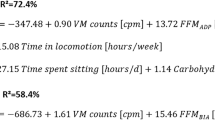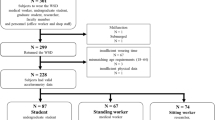Abstract
Objective:
Assessing energy expenditure (EE) is important for the control of obesity. Daily step counts have become popular and constitute one practical technique for evaluating the physical activity (PA) in large population studies. However, information on the capacity of pedometers to track EE in free-living conditions remains scanty.
Subjects and methods:
The 24-h EE of 71 healthy adults was measured by indirect calorimetry in a large respiratory chamber. Two accelerometers were attached to the waist, one for counting the total daily steps (ACCSTEP) and another for measuring the anteroposterior whole body acceleration calculated as the root mean square of the acceleration signal at every second (ACCRMS).
Results:
The ACCSTEP was not associated with PA-related EE (PAEE) or 24-h EE. Body weight (BW) was the main determinant of both the values (explaining 30 and 75% of the variance, respectively). Approximately 8% (P<0.001) of the variance in PAEE was attributed to the ACCRMS after BW was accounted for, whereas the ACCSTEP did not explain any additional variance. A multiple stepwise regression analysis revealed that BW, height and ACCRMS were highly significant determinants of 24-h EE and accounted for as much as 83% of the total variance.
Conclusions:
Recording the number of steps per day does not provide accurate information on EE, and at best is only a crude predictor of the general PA in terms of displacement. In contrast, accelerometry signals are considered to be a more meaningful factor in the assessment of EE rather than step counts under sedentary conditions.
This is a preview of subscription content, access via your institution
Access options
Subscribe to this journal
Receive 12 print issues and online access
$259.00 per year
only $21.58 per issue
Buy this article
- Purchase on Springer Link
- Instant access to full article PDF
Prices may be subject to local taxes which are calculated during checkout

Similar content being viewed by others
References
Ayabe M, Kumahara H, Aoki J, Naito H, Katamoto S, Tanaka H (2008a). Quantifying time spent in moderate to vigorous intensity physical activity via stepping rate. Jpn J Phys Fit Sports Med 57, 453–462. [In Japanese: English abstract].
Ayabe M, Yoshioka M, Yahiro T, Higuchi H, Higaki Y, Aoki J et al. (2008b). Objectively measured age-related changes in the intensity distribution of physical activity in young to middle aged adults. J Phys Act Health 6, 419–425.
Bouten CV, Koekkoek KT, Verduin M, Kodde R, Janssen JD (1997). A triaxial accelerometer and portable data processing unit for the assessment of daily physical activity. IEEE Trans Biomed Eng 44, 136–147.
Bouten CV, Verboeket-van de Venne WP, Westerterp KR, Verduin M, Janssen JD (1996). Daily physical activity assessment: comparison between movement registration and doubly labeled water. J Appl Physiol 81, 1019–1026.
Bouten CV, Westerterp KR, Verduin M, Janssen JD (1994). Assessment of energy expenditure for physical activity using a triaxial accelerometer. Med Sci Sports Exerc 26, 1516–1523.
Bussmann JB, Hartgerink I, van der Woude LH, Stam HJ (2000). Measuring physical strain during ambulation with accelerometry. Med Sci Sports Exerc 32, 1462–1471.
Chan CB, Spangler E, Valcour J, Tudor-Locke C (2003). Cross-sectional relationship of pedometer-determined ambulatory activity to indicators of health. Obes Res 11, 1563–1570.
Crouter SE, Schneider PL, Karabulut M, Bassett Jr DR (2003). Validity of 10 electronic pedometers for measuring steps, distance, and energy cost. Med Sci Sports Exerc 35, 1455–1460.
Donnelly JE, Blair SN, Jakicic JM, Manore MM, Rankin JW, Smith BK (2009). American College of Sports Medicine Position Stand. Appropriate physical activity intervention strategies for weight loss and prevention of weight regain for adults. Med Sci Sports Exerc 41, 459–471.
Ekelund U, Aman J, Yngve A, Renman C, Westerterp K, Sjostrom M (2002). Physical activity but not energy expenditure is reduced in obese adolescents: a case-control study. Am J Clin Nutr 76, 935–941.
Falls HB, Humphrey LD (1976). Energy cost of running and walking in young women. Med Sci Sports 8, 9–13.
Fields DA, Goran MI, McCrory MA (2002). Body-composition assessment via air-displacement plethysmography in adults and children: a review. Am J Clin Nutr 75, 453–467.
Fogelholm M, Hiilloskorpi H, Laukkanen R, Oja P, Van Marken Lichtenbelt W, Westerterp K (1998). Assessment of energy expenditure in overweight women. Med Sci Sports Exerc 30, 1191–1197.
Foster RC, Lanningham-Foster LM, Manohar C, McCrady SK, Nysse LJ, Kaufman KR et al. (2005). Precision and accuracy of an ankle-worn accelerometer-based pedometer in step counting and energy expenditure. Prev Med 41, 778–783.
Gardner AW, Poehlman ET (1998). Assessment of free-living daily physical activity in older claudicants: Validation against the doubly labeled water technique. J Gerontol A Biol Sci Med Sci 53, M275–M280.
Herren R, Sparti A, Aminian K, Schutz Y (1999). The prediction of speed and incline in outdoor running in humans using accelerometry. Med Sci Sports Exerc 31, 1053–1059.
Hoos MB, Plasqui G, Gerver WJ, Westerterp KR (2003). Physical activity level measured by doubly labeled water and accelerometry in children. Eur J Appl Physiol 89, 624–626.
Iwane M, Arita M, Tomimoto S, Satani O, Matsumoto M, Miyashita K et al. (2000). Walking 10 000 steps/day or more reduces blood pressure and sympathetic nerve activity in mild essential hypertension. Hypertens Res 23, 573–580.
Jequier E, Schutz Y (1983). Long-term measurements of energy expenditure in humans using a respiration chamber. Am J Clin Nutr 38, 989–998.
Kumahara H, Ishii K, Tanaka H (2006). Physical activity monitoring for health management: practical techniques and methodological issues. Int J Sport Health Sci 4, 380–393.
Kumahara H, Schutz Y, Ayabe M, Yoshioka M, Yoshitake Y, Shindo M et al. (2004a). The use of uniaxial accelerometry for the assessment of physical-activity-related energy expenditure: a validation study against whole-body indirect calorimetry. Br J Nutr 91, 235–243.
Kumahara H, Tanaka H, Schutz Y (2004b). Daily physical activity assessment: what is the importance of upper limb movements vs whole body movements? Int J Obes Relat Metab Disord 28, 1105–1110.
Kumahara H, Tanaka H, Terrier P, Ishii K, Oppert JM, Guy-Grand B et al. (2004c). Comparison of 2 accelerometers for assessing daily energy expenditure in adults. J Phys Act Health 1, 270–280.
Leenders NY, Sherman WM, Nagaraja HN, Kien CL (2001). Evaluation of methods to assess physical activity in free-living conditions. Med Sci Sports Exerc 33, 1233–1240.
Levine JA, Eberhardt NL, Jensen MD (1999). Role of nonexercise activity thermogenesis in resistance to fat gain in humans. Science 283, 212–214.
Marshall SJ, Levy SS, Tudor-Locke CE, Kolkhorst FW, Wooten KM, Ji M et al. (2009). Translating physical activity recommendations into a pedometer-based step goal: 3000 steps in 30 min. Am J Prev Med 36, 410–415.
Masse LC, Fulton JE, Watson KL, Mahar MT, Meyers MC, Wong WW (2004). Influence of body composition on physical activity validation studies using doubly labeled water. J Appl Physiol 96, 1357–1364.
Melanson EL, Knoll JR, Bell ML, Donahoo WT, Hill JO, Nysse LJ et al. (2004). Commercially available pedometers: considerations for accurate step counting. Prev Med 39, 361–368.
Montoye HJ, Washburn R, Servais S, Ertl A, Webster JG, Nagle FJ (1983). Estimation of energy expenditure by a portable accelerometer. Med Sci Sports Exerc 15, 403–407.
Nichols JF, Morgan CG, Sarkin JA, Sallis JF, Calfas KJ (1999). Validity, reliability, and calibration of the Tritrac accelerometer as a measure of physical activity. Med Sci Sports Exerc 31, 908–912.
Plasqui G, Westerterp KR (2007). Physical activity assessment with accelerometers: an evaluation against doubly labeled water. Obesity (Silver Spring) 15, 2371–2379.
Rafamantanantsoa HH, Ebine N, Yoshioka M, Higuchi H, Yoshitake Y, Tanaka H et al. (2002). Validation of three alternative methods of measuring total energy expenditure against the doubly labeled water method in older Japanese men. J Nutr Sci Vitaminol 48, 517–523.
Saris WH, Blair SN, van Baak MA, Eaton SB, Davies PS, Di Pietro L et al. (2003). How much physical activity is enough to prevent unhealthy weight gain? Outcome of the IASO 1st Stock Conference and consensus statement. Obes Rev 4, 101–114.
Schneider P, Crouter S, DR B (2004). Pedometer measures of free-living physical activity: comparison of 13 models. Med Sci Sports Exerc 36, 331–335.
Schneider PL, Crouter SE, Lukajic O, Bassett Jr DR (2003). Accuracy and reliability of 10 pedometers for measuring steps over a 400-m walk. Med Sci Sports Exerc 35, 1779–1784.
Schoeller DA, Jefford G (2002). Determinants of the energy costs of light activities: inferences for interpreting doubly labeled water data. Int J Obes Relat Metab Disord 26, 97–101.
Schutz Y, Bessard T, Jequier E (1984). Diet-induced thermogenesis measured over a whole day in obese and nonobese women. Am J Clin Nutr 40, 542–552.
Schutz Y, Weinsier S, Terrier P, Durrer D (2002). A new accelerometric method to assess the daily walking practice. Int J Obes Relat Metab Disord 26, 111–118.
Sequeira MM, Rickenbach M, Wietlisbach V, Tullen B, Schutz Y (1995). Physical activity assessment using a pedometer and its comparison with a questionnaire in a large population survey. Am J Epidemiol 142, 989–999.
Snitker S, Tataranni PA, Ravussin E (2001). Spontaneous physical activity in a respiratory chamber is correlated to habitual physical activity. Int J Obes Relat Metab Disord 25, 1481–1486.
Swartz AM, Strath SJ, Bassett DR, Moore JB, Redwine BA, Groer M et al. (2003). Increasing daily walking improves glucose tolerance in overweight women. Prev Med 37, 356–362.
Tharion WJ, Yokota M, Buller MJ, DeLany JP, Hoyt RW (2004). Total energy expenditure estimated using a foot-contact pedometer. Med Sci Monit 10, CR504–CR509.
Thompson D, Batterham AM, Bock S, Robson C, Stokes K (2006). Assessment of low-to-moderate intensity physical activity thermogenesis in young adults using synchronized heart rate and accelerometry with branched-equation modeling. J Nutr 136, 1037–1042.
Tudor-Locke C, Bassett DRJ (2004). How many steps/day are enough? Preliminary pedometer indices for public health. Sports Med 34, 1–8.
Westerterp KR, Kester AD (2003). Physical activity in confined conditions as an indicator of free-living physical activity. Obes Res 11, 865–868.
Yamanouchi K, Shinozaki T, Chikada K, Nishikawa T, Ito K, Shimizu S et al. (1995). Daily walking combined with diet therapy is a useful means for obese NIDDM patients not only to reduce body weight but also to improve insulin sensitivity. Diabetes Care 18, 775–778.
Yoshioka M, Ayabe M, Yahiro T, Higuchi H, Higaki Y, St-Amand J et al. (2005). Long-period accelerometer monitoring shows the role of physical activity in overweight and obesity. Int J Obes (Lond) 29, 502–508.
Acknowledgements
We are grateful to the participants for their cooperation, as well as the Japanese associations/groups in Switzerland. We express our thanks to Professor M Shindo at the Fukuoka University, Dr Y Yoshitake at the National Institute of Fitness and Sports in Kanoya, Dr M Yoshioka at the Laval University Medical Center and the members of the Laboratory of Exercise Physiology, Faculty of Sports and Health Science, Fukuoka University, for their valuable assistance in making the preparations for this study. We thank Dr T Philippe for the accelerometry data analysis and Mr P Olivier for technical assistance in respiratory chamber measurements. HK was involved in study design and implementation, data collection and analysis and writing the manuscript. YS contributed to manage the study design, data acquisition and interpretation and editing of key aspects of the manuscript. HT obtained the funding and set up the study design and editing of the manuscript. This work was supported in part by the Fukuoka University Institute for Physical Activity.
Author information
Authors and Affiliations
Corresponding author
Rights and permissions
About this article
Cite this article
Kumahara, H., Tanaka, H. & Schutz, Y. Are pedometers adequate instruments for assessing energy expenditure?. Eur J Clin Nutr 63, 1425–1432 (2009). https://doi.org/10.1038/ejcn.2009.108
Received:
Revised:
Accepted:
Published:
Issue Date:
DOI: https://doi.org/10.1038/ejcn.2009.108
Keywords
This article is cited by
-
Decline in objective physical activity over a 10-year period in a Japanese elementary school
Journal of Physiological Anthropology (2015)



